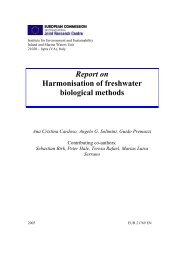Lakes and Watercourses
Lakes and Watercourses
Lakes and Watercourses
Create successful ePaper yourself
Turn your PDF publications into a flip-book with our unique Google optimized e-Paper software.
included. In addition to a large number of chemical parameters, there are<br />
several that provide direct or indirect measures of biodiversity.<br />
In all of the reports, assessments of environmental quality are h<strong>and</strong>led<br />
in the same way for all of the parameters, <strong>and</strong> usually consist of two separate<br />
parts (see also page 11). One part focuses on the effects that observed<br />
conditions can be expected to have on environment <strong>and</strong> human health.<br />
Since knowledge of such effects is often limited, the solution in many cases<br />
has been to present a preliminary classification scale based on general<br />
knowledge about the high <strong>and</strong> low values that are known to occur in Sweden.<br />
The second focuses on the extent to which measured values deviate<br />
from established reference values. In most cases, the reference value represents<br />
an approximation of a “natural” state, i.e. one that has been affected<br />
very little or not at all by human activities. Of course, “natural” is a concept<br />
that is not relevant to the preservation of cultural environments; in such<br />
contexts, reference values have a somewhat different meaning.<br />
The results of both parts are expressed on a scale of 1-5, where Class 1<br />
indicates slight deviations from reference values or no environmental<br />
effects, <strong>and</strong> Class 5 indicates very large deviations or very significant effects.<br />
The report on Contaminated Sites with its discussion of pollutants in<br />
heavily affected areas complements the other five reports. In those cases<br />
where the parameters are dealt with in several of the reports, which is particularly<br />
the cases for metals, the report on Contaminated Sites corresponds<br />
(see further pages 11-12). However, the various parameters cannot<br />
be compared with each other in terms of risks. The following paragraphs<br />
review the extent of agreement with corresponding or similar systems used<br />
by other countries <strong>and</strong> international organizations.<br />
INTERNATIONAL SYSTEMS FOR ENVIRONMENTAL QUALITY ASSESSMENT<br />
Among other countries, the assessment system that most resembles Sweden's<br />
is that of Norway. The Norwegian system includes “Classification of<br />
Environmental Quality in Fjords <strong>and</strong> Coastal Waters” <strong>and</strong> “Environmental<br />
Quality Classification of Fresh Water”. A five-level scale is used to classify<br />
current conditions <strong>and</strong> usability. Classifications are in some cases based on<br />
levels of pollution, in other cases on environmental effects.<br />
The European Union's proposal for a framework directive on water quality<br />
includes an assessment system that in many ways is similar to the Swedish<br />
Environmental Quality Criteria.<br />
If the parameters used in the latter are regarded as forms of environmental<br />
indicators, there are many such systems in use or under development. However,<br />
the concept of environmental indicators is much broader than the<br />
parameters of Environmental Quality Criteria.<br />
10















![Accommodation booking form [PDF]](https://img.yumpu.com/39471785/1/184x260/accommodation-booking-form-pdf.jpg?quality=85)

